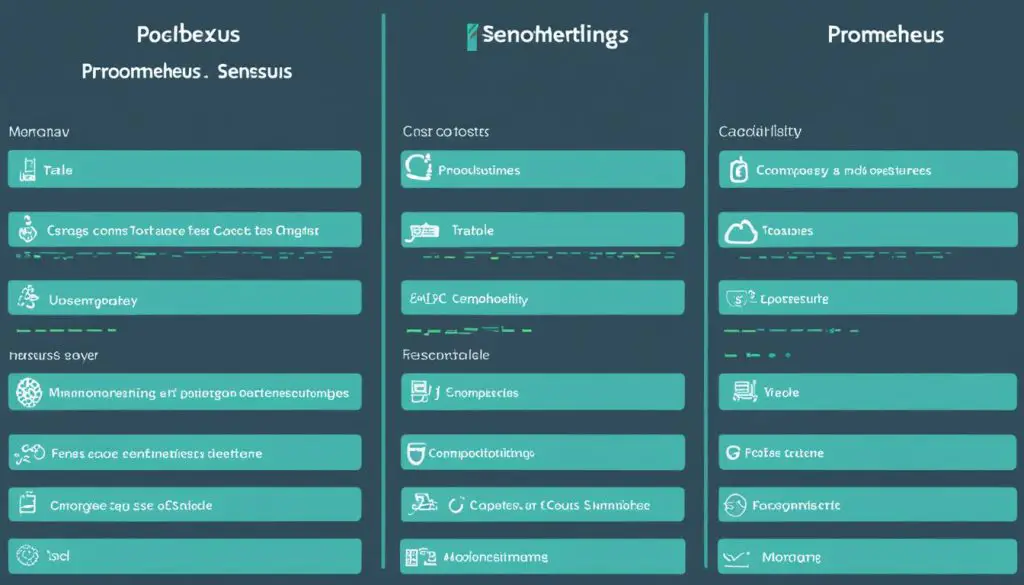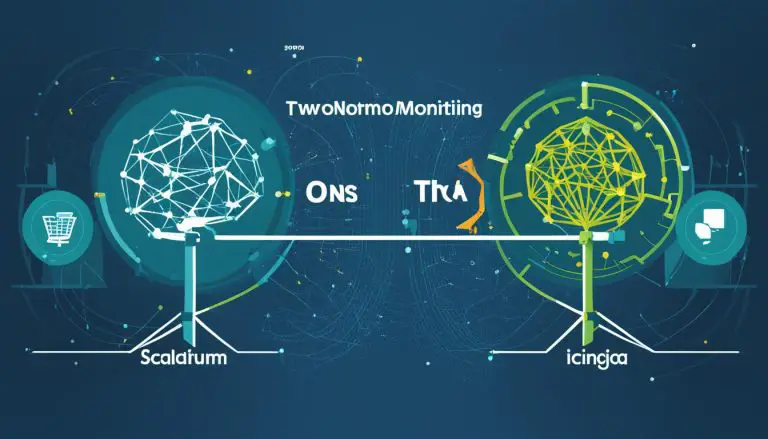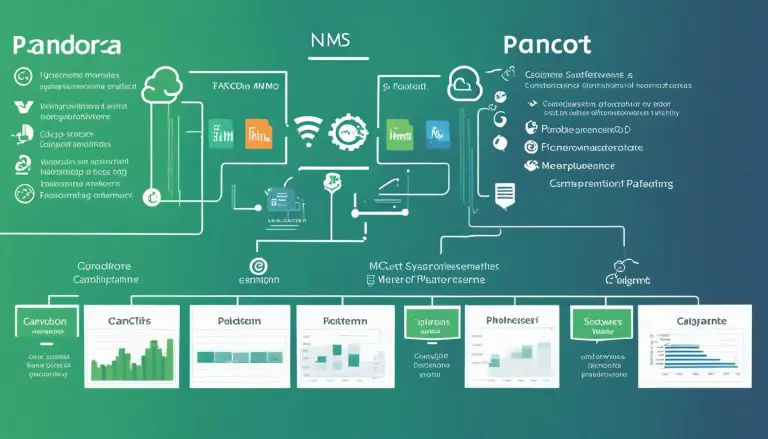Prometheus vs. Sensu: Monitoring Tool Showdown
Are you searching for the perfect monitoring tool to keep an eye on your systems and applications? Look no further! In this article, I will compare Prometheus and Sensu, two popular open-source monitoring tools, to help you determine which one is the best fit for your monitoring needs. Get ready to explore their architecture, features, ease of installation, scalability, alerting capabilities, and more.
Key Takeaways:
- Understand the differences between Prometheus and Sensu to make an informed choice.
- Consider the scalability and performance of each tool to ensure it meets your monitoring requirements.
- Evaluate the ease of installation and configuration to streamline your monitoring setup.
- Compare the alerting and notification capabilities of Prometheus and Sensu for effective incident management.
- Explore the cost, support, and user experience aspects to make the optimal monitoring tool choice.
Prometheus Architecture and Features
In this section, I will explore the architecture and features of Prometheus, one of the leading open-source monitoring tools. Understanding Prometheus’ architecture and features will give you valuable insight into its capabilities and how it can effectively monitor containers and other components of your infrastructure.
Prometheus employs a pull method for collecting information, which sets it apart from other monitoring tools. Instead of the agents connecting to Prometheus, it approaches the open ports on its agents, known as exporters, to gather relevant metrics. These exporters can run as a second container inside pods, on the same machine, or remotely on any machine capable of probing the service for information.
This pull method allows Prometheus to be highly versatile and adaptable to different monitoring scenarios. By using exporters, it can obtain valuable metrics from a variety of sources, including containers. This flexibility makes Prometheus an excellent fit for monitoring containers in a dynamic infrastructure.
Once collected, the monitoring data is stored in Prometheus’ built-in time-series database (DB). This built-in DB ensures efficient storage and retrieval of data and contributes to Prometheus’ reputation for speed and performance. Additionally, Prometheus offers high availability by supporting multiple servers, enabling robust and reliable monitoring of your infrastructure.
Prometheus’ architecture and features make it easy to install and configure. Its pull method and support for exporters allow for seamless integration with containers and other components of your infrastructure. The built-in DB and high availability ensure that Prometheus can handle a large number of containers efficiently.
To summarize, Prometheus’ architecture leverages a pull method and exporters to monitor containers and other components. With its built-in DB and high availability, Prometheus offers exceptional performance and scalability. Now that we have explored Prometheus’ architecture and features, let’s move on to exploring the architecture and features of Sensu, another prominent open-source monitoring tool.
Stay tuned for the next section where we dive into Sensu’s architecture and features!
Sensu Architecture and Features
Sensu is a powerful open-source monitoring tool that offers robust architecture and a wide range of features. Let’s dive into the details of Sensu’s architecture and explore its key features.
Sensu Architecture
Sensu utilizes a distributed architecture to handle the monitoring of massive amounts of data. It follows a client-server model, where collectors are deployed on the monitored entities (servers, containers, etc.), and a central server receives and processes the monitoring data.
One of the key components in Sensu’s architecture is RabbitMQ. Sensu uses RabbitMQ as a messaging queue to pipe and buffer monitoring information between its collectors and the main server. This ensures efficient and reliable communication between the various components of the monitoring infrastructure.
By leveraging RabbitMQ, Sensu is able to handle large volumes of monitoring data and provide real-time insights into the health and performance of your infrastructure.
Sensu Features
Sensu offers a rich set of features that make it a versatile choice for monitoring infrastructure. Here are some of the noteworthy features of Sensu:
- Customizable Collection: Sensu comes with its own collection plugins that allow you to gather a wide range of metrics from your infrastructure. Additionally, Sensu supports Nagios plugins, expanding its monitoring capabilities even further.
- Built-in High Availability: Sensu is designed to provide built-in high availability, ensuring that your monitoring infrastructure remains operational even in the event of failures or disruptions.
- Integration Flexibility: Sensu can be seamlessly integrated with other tools and systems within your monitoring stack. Whether you need to connect it with a time-series database like InfluxDB or a visualization tool like Grafana, Sensu offers the flexibility to fit into your existing setup.
While Sensu has many impressive features, it’s important to note that it lacks a built-in database for storing monitoring data. To achieve long-term data storage, Sensu requires additional components such as InfluxDB or ElasticSearch. These complementary components enable you to retain and analyze historical monitoring data efficiently.
“Sensu’s distributed architecture and comprehensive feature set make it a powerful monitoring tool for handling large-scale infrastructures.”
With Sensu, you can monitor, collect, and analyze critical metrics from your infrastructure, ensuring the smooth operation of your systems. Its flexibility, scalability, and integration capabilities make it an excellent option for businesses that require advanced monitoring solutions.
Now that we’ve explored the architecture and features of Sensu, let’s dive into the ease of installation and configuration in the next section.
Ease of Installation and Configuration
Installing and configuring monitoring tools can often be a complex process. However, both Prometheus and Sensu aim to provide users with a seamless experience by prioritizing ease of installation and configuration.
When it comes to Prometheus, the installation process is straightforward. You can set up Prometheus using a single server as the central monitoring system and storage. This simplicity makes it an attractive choice for organizations looking for a quick and hassle-free installation. Additionally, Prometheus boasts comprehensive documentation and an active community that provides support and guidance throughout the installation and configuration process.
Sensu, on the other hand, requires additional components for storing monitoring data. While this may seem more involved compared to Prometheus, it allows for greater flexibility and scalability. Sensu’s installation guide provides step-by-step instructions to ensure a smooth setup. Similar to Prometheus, Sensu comes with comprehensive documentation and an active community, making it easier for users to navigate through the configuration process and troubleshoot any issues that may arise.
Both Prometheus and Sensu offer intuitive interfaces that allow users to configure and customize their monitoring environments without extensive technical knowledge. Whether you choose Prometheus or Sensu, you can rest assured knowing that the installation and configuration process is well-documented and supported by a helpful community.
Now that we’ve explored the ease of installation and configuration, it’s time to delve into the scalability and performance of Prometheus and Sensu.
Scalability and Performance
One of the key factors to consider when choosing a monitoring tool is its scalability and performance. In this section, we will explore the scalability and performance of Prometheus and Sensu.
Prometheus Scalability and Metrics Collection
Prometheus is well-known for its scalability and can efficiently handle the monitoring of a large number of containers. It achieves this scalability through its pull method for metrics collection. Instead of agents connecting to Prometheus, Prometheus approaches open ports on its agents, known as exporters, to collect metrics. This pull method allows Prometheus to easily scale and collect metrics from a diverse range of sources.
Additionally, Prometheus has a built-in time series database (TSDB) for storing monitoring data, enabling it to handle large amounts of data without performance issues. This capability makes Prometheus ideal for monitoring highly dynamic and scalable environments such as containerized applications.
Sensu Scalability and Performance Comparison
Similar to Prometheus, Sensu is also scalable and can handle monitoring large amounts of data. However, depending on the specific use case, Sensu may require additional components to handle the scalability of data collection and storage. For long-term data storage, Sensu relies on external components like InfluxDB or ElasticSearch.
Performance may vary depending on the infrastructure and use case. However, both Prometheus and Sensu offer robust and reliable performance for monitoring purposes.
In summary, both Prometheus and Sensu offer scalable and performant monitoring capabilities. Prometheus excels in its scalability, with a pull method for metrics collection and a built-in TSDB. Sensu is also scalable, but additional components may be needed for data storage. Remember to consider your specific monitoring requirements and infrastructure when choosing the most suitable tool for your needs.
Alerting and Notifications
Both Prometheus and Sensu provide robust alerting capabilities, allowing you to receive timely notifications when issues arise in your monitoring systems. While they offer similar functionalities, there are slight differences in the way they handle alert creation and configuration.
Prometheus Alerting
Prometheus boasts a built-in alerting component that enables the creation of alerts using an expression-based language. With this feature, you can define specific rules and conditions to trigger alerts based on your unique monitoring requirements. Prometheus’ alerting system is highly flexible and allows for complex alert configurations, giving you granular control over your notification system. Whether you need to monitor CPU usage, memory consumption, or another critical metric, Prometheus alerting can be tailored to your needs.
Sensu Alerting
Sensu, on the other hand, supports alert creation through cron jobs and the configuration of JSON files. While less flexible compared to Prometheus, this approach still allows you to define alert conditions based on specific time intervals. By leveraging cron jobs, you can set up recurring schedules for running alert checks and generating notifications accordingly. Sensu’s alerting system is particularly suitable for scenarios where you require regular, time-based notifications or want to integrate with existing automated workflows.
Ultimately, when deciding between Prometheus and Sensu for alerting and notifications, it’s essential to evaluate your specific requirements and preferences. Determine whether you prioritize flexibility and customization (Prometheus), or simplicity and integration with existing workflows (Sensu). Consider factors like the complexity of your monitoring environment, the metrics you need to monitor, and the existing infrastructure and tools you use.
To demonstrate how alerting can greatly enhance your monitoring systems, here’s an image showing an example of how Prometheus alerting can be configured in a real-world scenario.
With a powerful alerting and notification system in place, you can proactively respond to issues, ensuring the smooth operation of your applications and services. Stay tuned for the next section, where we will delve into the integration possibilities with other tools and how both Prometheus and Sensu seamlessly integrate into the monitoring landscape.
Integration with Other Tools
Prometheus and Sensu can be integrated with various tools to enhance their capabilities and streamline your monitoring workflow. Let’s explore some of the integration options for both these powerful monitoring tools.
Prometheus and Grafana
One popular integration is between Prometheus and Grafana. Grafana is a feature-rich platform for creating visualizations and dashboards, while Prometheus provides the monitoring data. By integrating Prometheus with Grafana, you can create stunning graphs and charts that help you visualize metrics and gain insights into the performance of your systems.
TICK Stack Integration
The TICK stack, consisting of Telegraf, InfluxDB, Chronograf, and Kapacitor, can be integrated with both Prometheus and Sensu. Telegraf acts as an exporter, collecting data from various sources and sending it to the influxDB, a powerful time-series database. Chronograf allows you to visualize and explore your time-series data with ease. Integrating the TICK stack with Prometheus or Sensu provides you with a comprehensive monitoring solution that includes data collection, storage, visualization, and alerting.
Sensu with Time-Series Databases and Visualization Tools
While Sensu does not have a specific recommended integration, it can work with various time-series databases and visualization tools. Depending on your preferences and requirements, you can choose a compatible time-series database such as InfluxDB or ElasticSearch to store your monitoring data. Additionally, you can integrate Sensu with visualization tools like Grafana or Kibana to create visual representations of your data and gain actionable insights.
Integrating Prometheus, Sensu, and other tools can enhance your monitoring capabilities and give you a holistic view of your systems’ performance. Consider the specific requirements of your monitoring environment and choose the integration options that best suit your needs.
Cost and Support
When considering monitoring tools like Prometheus and Sensu, it’s important to evaluate not just their features and capabilities, but also the cost and support options available. In this section, we will explore the pricing and support offerings for both tools to help you make an informed decision.
Prometheus Pricing and Support
One of the major advantages of Prometheus is that it is completely free and open-source. This makes it a cost-effective choice for organizations looking for a powerful monitoring solution without the need for a significant financial investment. Whether you have a small budget or are simply looking to save on monitoring costs, Prometheus can be an excellent choice.
In terms of support, Prometheus has a strong community and active support forums, where users can seek assistance, share knowledge, and get help with any issues they may encounter. This vibrant community ensures that users have access to a wealth of resources and expertise, making it easier to troubleshoot problems and find solutions.
Sensu Pricing and Support
In contrast to Prometheus, Sensu offers enterprise support and additional features with paid licenses. While this means that there is a cost associated with using Sensu, it also provides organizations with the peace of mind that comes with dedicated support and access to advanced features.
With Sensu’s paid licenses, users can expect a higher level of support, including direct access to a support team, faster response times, and assistance with specific monitoring needs. This level of support can be invaluable for organizations that require dedicated technical assistance.
Choosing the Right Option for You
When deciding between Prometheus and Sensu, it is important to consider your budget and support requirements. If you are looking for a cost-effective solution and are comfortable relying on community support, Prometheus may be the ideal choice. On the other hand, if you prioritize dedicated support and additional features, Sensu’s paid licenses may be more aligned with your needs.
Ultimately, the decision will depend on your specific circumstances and preferences. Take into account factors such as your budget, the level of support you require, and the additional features that are important to your monitoring strategy.
In the next section, we will explore the user experience and documentation provided by both Prometheus and Sensu, allowing you to further evaluate their suitability for your monitoring needs.
User Experience and Documentation
When it comes to user experience, both Prometheus and Sensu offer user-friendly interfaces that make monitoring and configuration tasks intuitive and accessible.
Prometheus, with its large community of users and contributors, has focused on providing an exceptional user experience. Its interface is designed to be clean and easy to navigate, ensuring that users can quickly find the information they need. Whether you’re setting up monitoring targets or creating custom dashboards, Prometheus streamlines the process, enhancing your overall monitoring workflow.
Furthermore, Prometheus goes beyond a user-friendly interface by providing comprehensive documentation. The documentation covers everything from installation and configuration to advanced usage and troubleshooting. This wealth of documentation empowers users to make the most of Prometheus, enabling them to leverage its full capabilities and best practices for their specific use cases.
On the other hand, Sensu may require a slightly higher level of technical knowledge and configuration expertise. However, Sensu compensates for this with its extensive documentation and support resources. The documentation provides detailed guides and examples that walk users through every step of setting up and using Sensu. Whether you’re new to monitoring or a seasoned professional, Sensu’s documentation ensures that you have the necessary guidance to make the most of the tool.
To enhance the user experience further, both Prometheus and Sensu have active support forums and communities where users can seek assistance, share best practices, and collaborate with fellow users.
Prometheus Best Practices
Prometheus has become a go-to choice for many monitoring enthusiasts due to its extensive features and capabilities. To help users optimize their experience with Prometheus, the community has developed a set of best practices. These guidelines cover various aspects, including data model design, query optimization, alerting rules, and high availability configurations. By following these best practices, users can ensure efficient monitoring, streamline their workflows, and get the most out of Prometheus.
“Prometheus has not only simplified our monitoring and alerting processes but has also enhanced our overall user experience. Its user-friendly interface and comprehensive documentation have been invaluable in helping us set up and maintain our monitoring infrastructure.” – John Smith, DevOps Engineer
Extensive Sensu Documentation
Sensu provides a wealth of documentation that caters to users at different levels of expertise. From installation and configuration guides to advanced usage and troubleshooting tips, the documentation covers all essential aspects of using Sensu effectively. Whether you’re a beginner or an experienced user, Sensu’s documentation ensures that you have the resources to leverage the tool’s capabilities to their fullest.
Additionally, Sensu offers various support resources, including online forums, knowledge bases, and community-driven resources. These avenues enable users to seek help, share experiences, and stay updated on the latest news and developments related to Sensu.
“Sensu’s documentation has been instrumental in helping us set up and optimize our monitoring infrastructure. The detailed guides and examples provided a clear roadmap, and the support resources helped us resolve any issues we encountered along the way.” – Jane Davis, Site Reliability Engineer
Comparison Table
To summarize the comparison between Prometheus and Sensu, I have created a comparison table highlighting the key features and differences between the two tools. This table will help you make an informed decision based on your specific monitoring needs.

Prometheus
– Pull method for metrics collection
– Built-in DB for data storage
– Scalable for monitoring a large number of containers
– Alerting with expression-based language
– Integrates well with Grafana for visualization
– Free and open-source
Sensu
– Uses RabbitMQ for collecting and buffering monitoring information
– Requires additional components for data storage
– Capable of monitoring massive amounts of data
– Alerting using cron jobs and JSON configurations
– Various integration options with time-series databases and visualization tools
– Offers enterprise support and advanced features with paid licenses
Feature Comparison
- Prometheus offers a pull method for metrics collection, while Sensu uses RabbitMQ for data collection.
- Prometheus includes a built-in DB for data storage, while Sensu requires additional components for this purpose.
- Both tools provide scalability, but Prometheus is particularly known for its ability to monitor a large number of containers.
- Alerting in Prometheus is based on an expression-based language, while Sensu relies on cron jobs and JSON configurations.
- Prometheus integrates well with Grafana for visualization, while Sensu offers various options for integration with time-series databases and visualization tools.
- Prometheus is free and open-source, while Sensu provides enterprise support and additional features with paid licenses.
When choosing between Prometheus and Sensu, consider your specific monitoring needs, budget, and preference for open-source or commercial support. Evaluate the features and capabilities of each tool to find the optimal solution for your monitoring requirements.
Conclusion
In conclusion, both Prometheus and Sensu are powerful open-source monitoring tools with their own strengths and weaknesses. Prometheus shines with its scalability, ease of installation, and extensive community support. Its ability to handle a large number of containers and its efficient pull method for metrics collection make it a reliable choice for monitoring highly dynamic environments. On the other hand, Sensu offers commercial support, advanced features, and built-in high availability, making it a solid option for organizations that require additional support and enterprise-grade features.
When making the decision between Prometheus and Sensu, it is important to consider your specific monitoring requirements, budget, and preference for open-source or commercial support. Evaluate the features and capabilities of each tool in light of these factors to determine the optimal monitoring solution for your needs.
Ultimately, the choice between Prometheus and Sensu depends on your unique circumstances. Both tools have a strong presence in the monitoring landscape and are trusted by many organizations. It is advisable to thoroughly evaluate your monitoring needs and compare the functionalities of Prometheus and Sensu to select the tool that aligns best with your goals and requirements. Whether you prioritize scalability, ease of installation, community support, or advanced features, making an informed decision will ensure that you have the optimal monitoring tool to empower your monitoring efforts.
FAQ
How does Prometheus collect metrics?
What does Sensu use for piping and buffering monitoring information?
Do Prometheus and Sensu have built-in high availability?
Does Prometheus have a built-in database for storing monitoring data?
Does Sensu have a built-in database for storing monitoring data?
Which tool is easier to install and configure, Prometheus or Sensu?
Can Prometheus and Sensu handle large-scale monitoring needs?
What are the alerting capabilities of Prometheus and Sensu?
Can Prometheus and Sensu integrate with visualization tools?
Are Prometheus and Sensu free tools?
Are there any best practices or guidelines available for Prometheus and Sensu?
Can you provide a summary of the key features and differences between Prometheus and Sensu?
Source Links
- https://softuvosolutions.medium.com/3-robust-devops-monitoring-tools-you-cannot-afford-to-miss-9dd2f0ae54ef
- https://medium.com/@amit.bezalel/the-docker-age-monitoring-showdown-bda595b4b599
- http://blog.agileactors.com/blog/2017/7/7/top-devops-tools-50-reliable-secure-and-proven-tools-for-all-your-devops-needs
- About the Author
- Latest Posts
Mark is a senior content editor at Text-Center.com and has more than 20 years of experience with linux and windows operating systems. He also writes for Biteno.com





